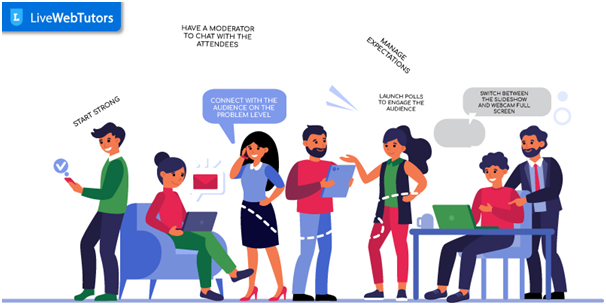Wouldn’t it be fantastic if you could keep your audience’s attention for the duration of the webinar? Imagine your audience eagerly anticipating your next move from the minute you open your mouth.
With these ten webinar presentation ideas, your audience will be on the edge of their seats, waiting to hear what you have to say next. You’ll discover how to make the most of your webinar platform’s interactive capabilities to produce an intriguing and engaging presentation.
Top 10 webinar tips to keep your audience engaged:
1) Get off to a fast start – open with a hook
Begin with an introduction that gets your audience’s attention right away. Starting a presentation for strangers with anything controversial or outlandish may feel out of place. However, if you want people to remember what you have to say, you must do so.
Start with 2-3 words that will grab their attention even before you introduce yourself or the webinar style. “Horrible landing pages that don’t convert squander 58 % of marketing spending. This webinar will teach you all you need to know about landing page design so you can nail it,”, as said by Elisa, a professional web analyst and an essay help service provider.
2) Manage expectations – what are they expecting to learn?
Tell them what they’ll learn at the end of the webinar now that you’ve gained their full attention. Your webinar participants expect to study and obtain practical knowledge. This is your chance to educate them.
Lay out a rough agenda for the webinar meeting and let them knows how long it will last.
Managing their expectations will ensure that they stay committed until the finish. Promising a “surprise” at the end of the webinar is a clever ploy. It might be a humorous video or a PDF hand-out.
3) Make a problem level connection with the audience
Establishing the problem is one of the most crucial steps. Your audience will only stay in the webinar if they believe their pressing problem is being addressed and will be resolved.
Create a mental image of the issue. Make them understand that they are the source of the problem. Tell them a tale about the last time they had to deal with this issue. Consider the following scenario:
“Don’t you hate it when you spend over 15 minutes composing an email just to have it ignored? Remember the last time you sent a message with your personality and praises only to receive no response? What a horrible sensation. Fortunately for you, that will change today.”
4) Change between the slideshow and the full-screen webcam
You almost probably have a slideshow or other visual aids to assist you in illustrating your ideas. That’s fantastic!
It’s vital, though, to avoid becoming a “background voice.”Plan out the elements of your webinar presentation that you want to emphasize the most when you’re planning it when you get to that stage, halt the slideshow and simply display your webcam. Make sure you’re using quality webinar software that lets you pause and resume your slideshow quickly.
This has a two-fold effect: first, it quickly re-engages their attention. Second, because you’re now speaking directly to them, they’ll remember it better. The slides have vanished, and your face has taken up the entire screen.
5) Hire a moderator to talk to the guests.
If you’ve done everything well, you’ll have more engagement than you can handle. Attendees are conversing with one another while concurrently asking you questions.
It’s hard to give a superb presentation while also reading the audience’s feedback. Invite a moderator or a co-host to the webinar to keep everyone engaged and heard. The moderator doesn’t even have to share their webcam; all they have to do is answer queries in the chat and ensure that your guests’ opinions and inquiries are heard.
6) Initialize polls in order to engage the audience
In a webinar, launching a pre-configured poll is a simple method to involve all of your guests at once and make them feel important. Polling is made more visible using webinar systems, which encourages participation.
After the voting, inform the guests of the results. Thank them for taking part in the survey and attempt to extract some inferences from it. It also gives your guests a sense of importance.
7) Ask feedback confirmation questions
First and foremost, these brief confirmation feedback questions make your audience feel obligated to pay attention. It causes a brief pause in the presentation and gives the impression that something significant has just been uttered. If they don’t pay attention and start typing 1’s in the conversation, it appears like they’re losing out on crucial information. They’ll instantly begin to concentrate more.
8) Exhibit video clips as examples and testimonials.
In your webinar, use brief video clips to demonstrate an example or display a testimonial from a prior pleased client.
When you start a video, the tempo changes slightly, and things get a little more interesting. The audio and visuals abruptly switch, grabbing the audience’s attention.
Modern webinar platforms allow you to pre-configure a YouTube video so that you may play it right away during your presentation.
9) Send out a captivating call to action
One of the most important reasons to communicate with your audience is because an engaged audience is more likely to respond to your call to action. A unique promotional text, an appealing button, and occasionally even an urgency timer can be included in the call-to-action.
The call-to-action is where the sales are made. Your call-to-action URL will be lost if you paste it into the conversation. Use the call-to-action tool to make it stand out and entice them to take action.
10) Answer questions from the audience on live video
Allow 10-15 minutes at the end of your webinar to accept questions from the audience and respond to them on live video. Attendees frequently have similar questions, so answering them will dispel any worries. This is the section of the webinar presentation that is perhaps the most personalized.
If the webinar software allows for question upvoting, that’s even better. You’ll be able to tell which questions are the most pressing.
Takeaways important
To summarise, begin your presentation with a powerful hook to pique people’s interests. Then provide a summary of what the participants will learn, with a few teasers thrown in for good measure.
Make sure your audience understands the issue you’re talking about. Alternate between the slideshow and your camera during your presentation to reclaim their attention when organizing your webinar, think about surveys, calls to action, and Q&A
In most cases, presentations do not include enough images. Showing a video clip or two to explain your argument can ensure you’re one step ahead. Finally, attempt to start a conversation. If you could simply have their confirmation that they understand, that would be fantastic. If necessary, bring in a moderator. Achieve the top score this semester with leading assignment help online providers assisting you.

